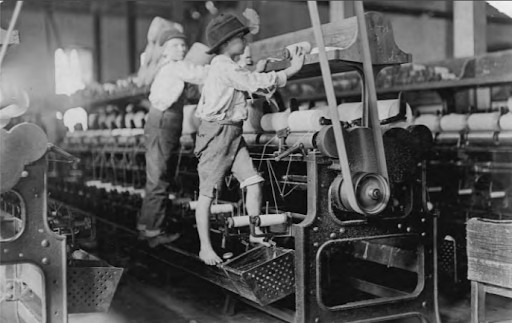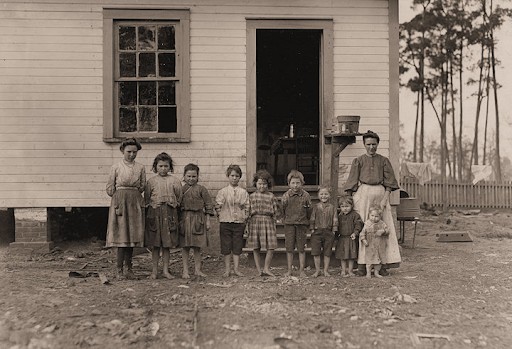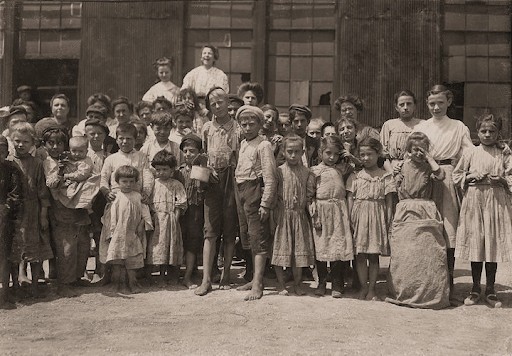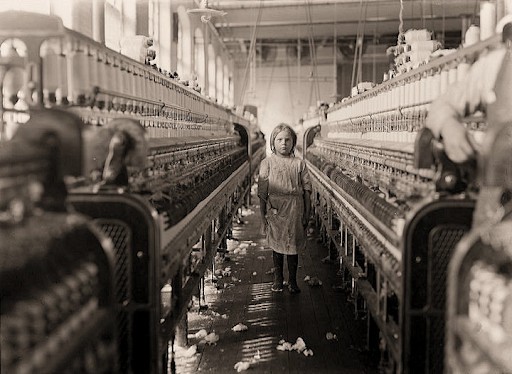Child Labor and the Athens Manufacturing Company
Introduction
Text-to-speech Audio
In 1828, four men, Augustin S. Clayton, Abram Walker, John Nesbitt, and William Dearing, drew up a charter for the Athens Manufacturing Company. This site, the Cedar Shoals area of the North Oconee, was chosen as the area for the new mill which subsequently expanded across the river over the next 100 years. In that period, this was referred to as the “Lower Mill” and what is now the University of Georgia's Chicopee Buildings, previously the Cooke & Brother Armory, was referred to as the “Upper Mill.” Eventually, Athens Manufacturing was purchased by Johnson & Johnson and renamed the Chicopee Manufacturing company in 1950. Here, workers specialized in manufacturing cotton and woolen yarns, helping the business remain profitable for over 100 years. In the antebellum period, work was split between slaves and white employees. However, because of the demand for labor in the fields, slaves were often confined to work there while poor white workers were the predominant labor force inside of the mills. Though the majority of workers were women, at one point in time Athens Manufacturing Company, like many textile mills, also employed children. Work for all people in mills such as this one was difficult and sometimes dangerous, the hazards of the workplace were equally, if not more, pronounced for children. This mill was one small part of the country’s difficult history of child labor.
Images
Two boys work to fix a broken bobbin by climbing onto the machine barefoot.

A widow and her children - the oldest 5 work in the mill alongside their mother earning $9 combined per week.

A group of mill children gather outside on their break.

A young girl stands among machines - Hines noticed she was steadily working despite the manager claiming she "just happened in".

An interview with a child mill worker, Oscar Cannell, in Athens Daily Herald, 1914.

Backstory and Context
Text-to-speech Audio
For centuries children have helped their parents with household chores and farm labor. This was true for white and Black children alike, though the circumstances of their work would have been entirely different. The Industrial Revolution ushered in a new age in which children increasingly helped their parents with income by working for wages nationwide. This represented an important shift in the ways in which children aided their parents. Children as young as seven held jobs in mills, mines, fields, factories, and pretty much any other mainstream manual-labor based workplace in the United States, making up approximately a quarter of the entire workforce by 1890. Because they were cheap and easy to employ, children were often seen as expendable by their employers which resulted in horrific abuse, mutilation, and sometimes the death of children working in these conditions. They often sacrificed their schooling and their freedom to work for just a few dollars a week, and if they were lucky enough to attend school, it was often held at night after their 10-hour shifts at work. The Athens Night School was founded specifically to provide education for children and adults who worked in Athens area mills. To showcase what they were learning, children would write to the Athens Daily Herald. In 1914 one student, Oscar Cannell, wrote, “I am at work everyday at the Athens Manufacturing Company. It is cold in the mill every morning. I go to school every night and have a good time before school. I try to study hard and learn my lessons. I am in the fourth grade.” Similar letters tell stories of lengthy days, poor working conditions, and experiences in the mills and at the school.
The images above show the conditions that children often faced in textile mills. Though these photographs are not from Athens, they depict common scenes from southern mills. Photographs such as these depict the working conditions in textile mills across the country, and it is important to note that most, if not all of these children appear to be white. From this we can infer that Black children (and presumably their parents) were excluded from work in the mills. The first depicts two young boys, who were too small to reach, climbing onto the spinning frame to fix a broken thread as the machine wound it around bobbins. The second image shows a very young girl working with loose cotton around her feet wearing tattered clothing, the manager of the mill claimed she “just happened in” even though the photographer noticed she was working steadily. The third image shows a group of children gathered outside their workplace during a break. The final image shows a widowed mother and her eleven children. She and the five oldest children worked in their town mill. She earned $4.50 a week and the children $4.50 a week combined. Take a minute to look at these images and think about some common characteristics of the children. What might their lives outside of the mill look like? What do these images signal about their financial situation?
The Athens Manufacturing Company employed so many children that it operated a school for them, helping them earn an education at the same time they worked. The mill also had a factory cemetery where workers and their families were buried. One family buried there is the Allgood family. John and Elizabeth Allgood worked and were buried there with their children; the oldest two named James (14) and Charles (16) were listed as workers of this mill in the 1880 census. Though we don’t know the details of their work here, at another unnamed mill in Athens a child of 15 made about $1.00 per day and a child of 11 made around .40 cents per day. Another account of child labor in Athens Manufacturing Company came from a 34-year-old who was interviewed in 1913 as part of a national child labor research project. She had worked there since she was 9 and had been weathered by many years of labor in poor conditions, though she maintained that for the first few years, she enjoyed the work. At the time of the interview, she worked surrounded by young children, and wished she could be anywhere else.
It wasn’t until 1938 that the Fair Labor Standards Act placed national restrictions on the minimum working age. However, efforts to regulate practices of child labor existed long before, ranging from Lewis Hines’s series of photographs from 1909, which attempted to draw attention to working conditions for children, to the activity of women’s social groups. Many women’s groups sought to improve local society, focusing on the promotion of education and the restriction of child labor. One such group, the Athens Woman’s Club, appointed three women to attend the National Child Labor Convention in Atlanta in 1908. At this fourth annual meeting, progressives from across the United States met to discuss the role of child labor and the dangers that accompanied it. Specifically, leaders and attendees of the convention focused on the vast differences of labor laws and conditions from state to state, noticing that southern mills were particularly notorious for poor working conditions and employment of young children. Many convention-goers and other progressives in the early 20th century believed that compulsory education laws and child labor reform went hand in hand. The first compulsory education law in Georgia was signed in 1916, however, children who completed the fourth grade or needed to work to support their families were exempt from the law. Later, education laws and child labor reform laws would place greater restrictions on when and at what age children were legally allowed to work.
Child labor laws have changed drastically over the last 100 years. Today, heavy restrictions are placed on teens between the ages of 14 and 17 who wish to work. Federal laws restrict 14 and 15-year-olds to only working 3 hours during a school day, 8 hours during a non-school day. Additionally, they may not work before 7 am or after 7 pm, and may not work during school hours. Minors under the age of 16 must register for a work permit through the Georgia Department of Labor. Restrictions on the types of jobs minors can work, the time of work and number of hours of work are in place to protect young workers. These measures were nonexistent in Georgia at the turn of the 20th century, children worked hard alongside their peers and parents in mills and factories across the country. The Athens Manufacturing Company and many like it had less-than-desirable working conditions and labor practices for many years before labor laws prevented them from doing so.
SSUSH13 Evaluate efforts to reform American society and politics in the Progressive Era.
b. Examine and explain the roles of women in reform movements.
d. Describe Progressive legislative actions including empowerment of the voter, labor laws, and the conservation movement.
Sources
“Athens Factory.”National Register Of Historic Places Inventory Nomination Form, United
States Department Of The Interior National Park Service, 1980.
Athens Woman's Club Minutes, 1899-1911. Vol. 1. Athens, GA: The Digital Library of Georgia,
University of Georgia Libraries, 2006.
De Graffenried, Clare. "Child Labor." Publications of the American Economic Association 5, no.
2 (1890): 71-149. http://www.jstor.org/stable/2485612.
Easom, Maxine Pinson, Patsy Hawkins Arnold, and Gary L. Doster. Across the River: the
People, Places, and Culture of East Athens. Athens, Ga: Across the River, 420 Millstone
Circle, 30605, 2019.
“East Athens Night School,” Athens Daily Herald, November 10, 1914, 7.
“East Athens Night School,” Athens Daily Herald, February 12, 1915, 2.
“Factory Burial Project.” Omeka RSS. Accessed October 21, 2019.
https://digilab.libs.uga.edu/cemetery/exhibits/show/history/factory.
Gagnon, Michael J., Transition to an Industrial South (Baton Rouge: Louisiana State University
Press, 2012), 206.
“Honor Roll at Night School. How the Young Folks Stood in teat Institution,” Athens Daily
Banner, February 9, 1900, 4.
Lovejoy, Owen R. “Child’s Statesman Says Child Labor Shackles Millions.” The Athens Banner,
February 10, 1923. https://gahistoricnewspapers.galileo.usg.edu/lccn/sn88054098/1923-02-10/ed-1/seq-5/#city=Athens&rows=12&proxtext=child+labor&sequence=0&index=3®ion=north&words=
child+Child+Labor+labor+laborer&page=1
“Mapping Child Labor Laws and Compulsory Education in Early 20th C. US.” Mapping
American Childhoods. Accessed October 15, 2019.
http://blog.uvm.edu/mcope-childhoods/working-and-schooling-mapping-child-labor-laws-and-compulsory-education-in-early-20th-c-us/.
Park, R. E. “The Needs of Country Schools.” In Catalogue of the Officers and Students of the
University of Georgia, Athens, Vol. IX, 1909-1910.
Photograph. Library of Congress. Library of Congress. Accessed October 18, 2019.
http://www.loc.gov/pictures/search/?st=grid&co=nclc.
“Provide for Them,” Athens Weekly Banner-Watchman, January 18, 1887, 1.
Roper, Daniel M. “Vanishing Georgia: Children of the Loom.” Georgia Backroads Magazine,
2009.
Sheldon, Laurana. “Child Labor.” The Winder News, October 16, 1913.
https://gahistoricnewspapers.galileo.usg.edu/lccn/sn89053008/1913-10-16/ed-1/seq-13/#i
ndex=0&rows=12&proxtext=athens ga child labor&sequence=0&words=Athens Child Ga Labor&page=1.
Williams, Arden. “Textile Industry.” New Georgia Encyclopedia. Accessed October 21, 2019.
https://www.georgiaencyclopedia.org/articles/business-economy/textile-industry.
Lewis Hine, National Child Labor Committee Collection, Library of Congress, retrieved from http://www.loc.gov/pictures/search/?st=grid&co=nclc
Lewis Hine, National Child Labor Committee Collection, Library of Congress, retrieved from http://www.loc.gov/pictures/search/?st=grid&co=nclc
Lewis Hine, National Child Labor Committee Collection, Library of Congress, retrieved from http://www.loc.gov/pictures/search/?st=grid&co=nclc
Lewis Hine, National Child Labor Committee Collection, Library of Congress, retrieved from http://www.loc.gov/pictures/search/?st=grid&co=nclc
“East Athens Night School,” Athens Daily Herald, November 10, 1914, 7.
